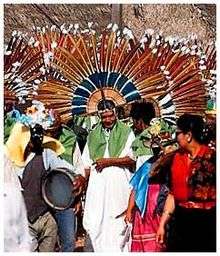Moxo languages
Moxo (also known as Mojo, pronounced 'Moho') is any of the Arawakan languages spoken by the Moxo people of Northeastern Bolivia. The two extant languages of the Moxo people, Trinitario and Ignaciano, are as distinct from one another as they are from neighboring Arawakan languages. Extinct Magiana was also distinct.
| Moxo | |
|---|---|
| Mojos | |
| Native to | Bolivia |
| Region | Beni Department |
| Ethnicity | 21,000 Moxo people (2004)[1] |
Native speakers | 10,000 (2000–2004)[1] |
Arawakan
| |
| Language codes | |
| ISO 639-3 | Either:ign – Ignaciano Moxostrn – Trinitario Moxos |
| Glottolog | moxo1234 Moxo[2]magi1242 Magiana[3] |
Moxo languages have an active–stative syntax.[4]

Sociolinguistic background
The languages belong to a group of tribes that originally ranged through the upper Mamoré, extending east and west from the Guapure (Itenes) to the Beni, and are now centered in the Province of Moxos, Department of Beni, Bolivia.[5]
Ignaciano is used in town meetings unless outsiders are present, and it is a required subject in the lower school grades, one session per week. Perhaps half of the children learn Ignaciano. By the 1980s there were fewer than 100 monolinguals, all older than 30.
Classification
The Moxo languages are most closely related to Bauré, Pauna, and Paikonéka. Together, they form the Mamoré-Guaporé languages (named after the Mamoré River and Guaporé River). Classification by Jolkesky (2016):[6]:8
Classification by Danielsen (2011) and Danielsen & Terhart (2014: 226):[7][8]
Word lists
The following is a wordlist containing sample words from English to Moxos:
| English | Moxos |
|---|---|
| One | Ikapia |
| Two | Apisá |
| Three | Impúse |
| Man | Ehiro |
| Woman | Eseno |
| Sun | Sáche |
| Water | Uni |
| Fire | Yuku |
| Head | Nuxuti |
| Hand | Nubupe |
| Corn | Suru |
Magíana word list from the late 1700s published in Palau and Saiz (1989):[9]:170
Spanish gloss English gloss Magíana bueno good shiomá malo bad shiomallama el padre father papá la madre mother kay el hermano brother nomasqui uno one huestiche dos two heravetá
See also
- Indigenous languages of the Americas
- Classification schemes for indigenous languages of the Americas
- Mesoamerican languages
- Language families and languages
- Classification of indigenous peoples of the Americas
- Indigenous peoples of the Americas
- Category:Indigenous languages of the Americas (division into geocultural areas)
- Languages of Peru
- List of Spanish words of Indigenous American Indian origin
Further reading
- Carvalho, Fernando O. de; Françoise Rose. Comparative reconstruction of Proto-Mojeño and the phonological diversification of Mojeño dialects. LIAMES, Campinas, v. 18, n. 1, p. 3–44, Jan./Jun. 2018. doi:10.20396/liames.v1i1.8648804
References
- Ignaciano Moxos at Ethnologue (18th ed., 2015)
Trinitario Moxos at Ethnologue (18th ed., 2015) - Hammarström, Harald; Forkel, Robert; Haspelmath, Martin, eds. (2017). "Moxo". Glottolog 3.0. Jena, Germany: Max Planck Institute for the Science of Human History.
- Hammarström, Harald; Forkel, Robert; Haspelmath, Martin, eds. (2017). "Magiana". Glottolog 3.0. Jena, Germany: Max Planck Institute for the Science of Human History.
- Aikhenvald, "Arawak", in Dixon & Aikhenvald, eds., The Amazonian Languages, 1999.
- http://www.newadvent.org/cathen/10606b.htm, New Advent, Moxos Indians, Retrieved February 10, 2011.
- Jolkesky, Marcelo. 2016. Uma reconstrução do proto-mamoré-guaporé (família arawák). LIAMES 16: 7-37.
- Danielsen, Swintha (2011). The personal paradigms in Baure and other South Arawakan languages. In Antoine Guillaume; Françoise Rose (eds.). International Journal of American Linguistics 77(4): 495-520.
- Danielsen, Swintha; Terhart, Lena (2014). Paunaka. In Mily Crevels; Pieter Muysken (eds.). Lenguas de Bolivia, vol. III: Oriente, pp. 221-258. La Paz: Plural Editores.
- Palau, Mercedes and Blanca Saiz. 1989. Moxos: Descripciones exactas e historia fiel de los indios, animales y plantas de la provincia de Moxos en el virreinato del Perú por Lázaro de Ribera, 1786-1794. Madrid: El Viso.